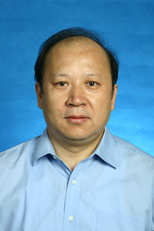 |
Fangzhen Sun
Phone: 86-10-64807677
Fax:
Email:
Research Area :
|
| Sun Group
Fangzhen Sun, head of the laboratory.
Mechanisms of egg activation and sperm nucleus remodeling during fertilization Fertilization is an essential process for reproduction and development. The goal is to understand two important events of fertilization, namely egg activation by the sperm and sperm nucleus remodeling by egg factors, at the molecular and cellular level. The research in the lab has been focusing on identification of the paternal and maternal molecules that determine these events, and their mechanisms of action. In application, these studies may also enable us to improve the efficiency of embryonic development of nuclear transplanted embryos for the purposes of animal cloning or human therapeutic cloning.
The main focus at present is to understand how the sperm initiates the embryonic developmental program stored in the egg by generating transient rises in the intracellular calcium concentration, a phenomenon observed in all animal species so far studied. This calcium signaling process plays an essential role in egg activation and early embryonic development. The scientists in the lab have provided evidence to show that the orderly sequence of calcium oscillations in mammalian eggs is critically dependent upon two essential factors, a sperm-derived protein factor triggers the release of calcium from the intracellular store, while a maternal machinery determines whether the oscillatory process can persist. They have found that the activity of the sperm-derived protein factor is highly conserved during evolution. Event cytosolic sperm extracts derived plants can induce calcium oscillations in mammalian eggs when microinjected. They are attempting to purify this sperm protein factor and to understand how this factor initiates calcium release from the intracellular store through the InsP3-receptor.
Moreover, the group has reported for the first time that sperm factor-induced calcium oscillations are mediated by a maternal machinery that functions only once in mammalian eggs. They are now studying the nature and characteristics of this machinery. In addition, they are determining the specificity of the signaling pathway that the sperm protein factor used for triggering calcium release from the intracellular calcium store.
KEY PUBLICATIONS
1. Di Zhang, Lei Pan, Ling-Hai Yang, Xiao-Ke He, Xiu-Ying Huang and Fang-Zhen Sun. Sr2+ promotes calcium oscillations in mouse meiotic oocytes and mitotic embryos through InsP3 receptors and require activation of PLC and a synergistic action of InsP3. Human Reproduction, 20(11):3053-3061, 2005.
2. Longbo Cui, Xiuying Huang and Fangzhen Sun. Nucleocytoplasmic Ratio of Fully Grown germinal vesicle Oocytes Is Essential for Mouse Meiotic Chromosome Segregation and Alignment, Spindle Shape and Early Embryonic Development. Human Reproduction, 20(10):2946-2953, 2005.
3. Dong, J.B., Tang, T.S. and Sun, F.Z. Xenopus and chicken sperm contain a cytosolic soluble factor which can trigger calcium oscillations in mouse eggs. Biochem. Biophys. Research Commun., 268:947-951, 2000.
4. Tang, T.S., Dong, J.B., Huang, X.Y. and Sun, F.Z. Ca2+ oscillations induced by a cytosolic sperm protein factor are mediated by a maternal machinery that functions only once in mammalian eggs. Development, 127:1141-1151, 2000.
5. Li, S.T., Huang, XY., & Sun, F.Z. Flowering plant sperm contains a cytosolic soluble protein factor which can trigger calcium oscillations in mouse eggs. Biochem. Biophys. Research Commun., 287(1): 56-59,2001 |
|



